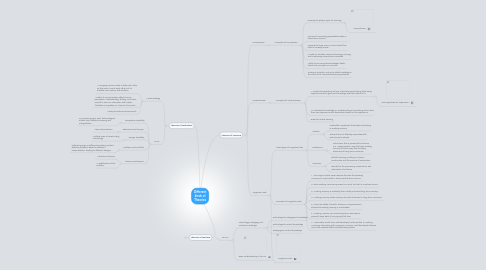
1. Theories of Technology
1.1. Media Ecology
1.1.1. "Arranging various media to help each other so they won't cancel each other out, to buttress one medium with another."
1.1.2. "Media of communication affects human perception, understanding, feeling, and value, as well as how our interaction with media facilitates or impedes our chances of survival."
1.1.3. Study of media as environments
1.2. SCOT
1.2.1. Interpretive Flexibility
1.2.1.1. For various groups, each techonological artifact has a different meaning and interpretation.
1.2.2. Relevant Social Groups
1.2.2.1. uses and producers
1.2.3. Design Flexibility
1.2.3.1. Multiple ways of constructing technology.
1.2.4. Problems and Conflicts
1.2.4.1. Different groups in different societies construct different problems based on different interpretations, leading to different designs.
1.2.5. Closure mechanisms
1.2.5.1. 1.Rhetorical Closure
1.2.5.2. 2. Redefinition of the Problem
2. Theories of Teaching
2.1. TPACK
2.1.1. Technology Pedagogy and Content Knowledge
2.1.1.1. Technological Pedagogical Knowledge
2.1.1.2. Technological content knowledge
2.1.1.3. Pedagogical content knowledge
2.1.2. Basic understanding of TPACK
3. Theories of Learning
3.1. Connectivism
3.1.1. Principles of connetivisim
3.1.1.1. Diversity of options open for learning
3.1.1.1.1. Connectivism
3.1.1.2. Process of connecting specialized nodes or information sources
3.1.1.3. Capacity to know more is more critical than what is currently known
3.1.1.4. In order to facilitate continual learning nurturing and maintianing connections is needed
3.1.1.5. Ability to see connections between fields, ideas, and concepts is a core skill
3.1.1.6. Currency, accurate, and up-to-date knowledge is the intent of all connectivist learning activities.
3.2. Constructivsim
3.2.1. Principles of constructivisim
3.2.1.1. A constructive teaching will use active learning teaching style (using experienments) to gain more knowlege and then reflect on it.
3.2.1.1.1. Learning based on experience
3.2.1.2. An individual's knowledge or understanding of something somes from their own experience and observation based on the experience.
3.2.1.3. Based on active learning
3.3. Cognitive Load
3.3.1. Three types of Cognitive load
3.3.1.1. Intrinsic
3.3.1.1.1. irreducible complexity of elements interacting in working memory
3.3.1.1.2. inherent level of difficulty associated with instructional materials
3.3.1.2. Extraneous
3.3.1.2.1. instructions that is presented to learners in a "inappropriate" way that force working memory to focus away from building schemas into long term memories
3.3.1.3. Germane
3.3.1.3.1. effortful learning resulting in Schema construction and the process of automation
3.3.1.3.2. devoted to the processing, construction and automation of schemas
3.3.2. Principles of Cognitive Load
3.3.2.1. 1. The magic number seven depicts the idea that working Memory can only handle 7 disconnected items at once.
3.3.2.2. 2. when working memories process too much too fast, an overload occurs.
3.3.2.3. 3. Working memory is assited by the virtually unlimited long term memory.
3.3.2.4. 4. Working memory writes memory structure (schemas) in long term memories.
3.3.2.5. 5. When the ability to build a schema is compromised it shows that working memory is overloaded.
3.3.2.6. 6. Working Memory can access long term memories in powerful ways when it has capacity left over.
3.3.2.7. 7. Automation results from well developed Schemas due to Working Memory's interaction with Long Term Memory. Well developed schemas come with repeated effort and effective practice.
3.3.3. Cognitive Load
